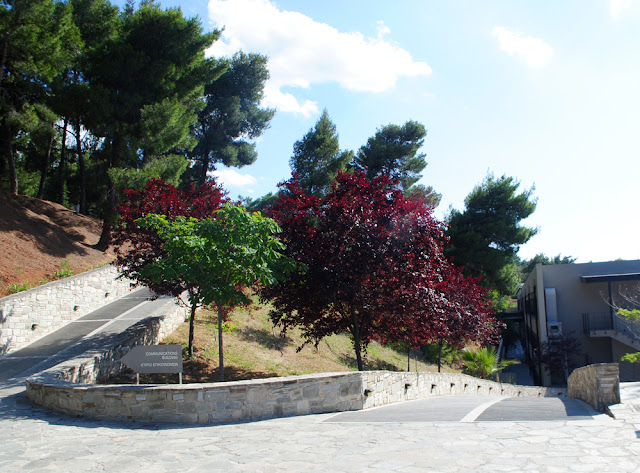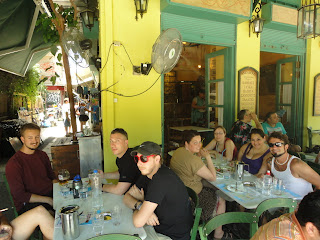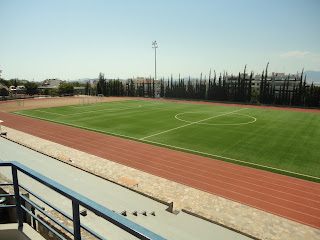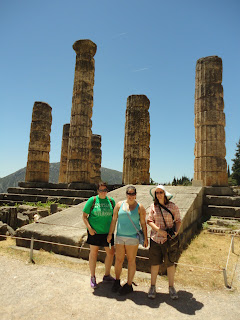Day 10: Athens, the Agora (and Roman Agora too)
The second theme of the class deals with the influence of Greek cultural forms on Roman life, even in a city like Athens, rejuvenated under the Nervan-Antonine emperors like Hadrian. The SAG 2012 crew boarded a bus in the late morning and then a subway train to the Monastiraki stop,where the Athens Agora is located. First we refreshed ourselves on a lite meal at a place with the best coffee (and chocolate cake) in town.
Here "Italian Holly" shows off her monstrous slice of chocolate cake to Kate.
We then began to walk towards the Athenian Agora, the central marketplace and heart of civic life of ancient Athens. As we approached the entrance an active excavation was visible. This is the Athenian Agora excavation run by the American School of Classical Studies in Athens. They have an active field school and have been excavating here since the 1931. This is their website on the dig:
http://www.ascsa.edu.gr/index.php/excavationagora/
We were told to ask for Prof. John Camp, the Director of the excavation at the school field headquarters located in the basement of the Stoa of Attalos. I introduced myself to the Director and he very graciously allowed us on site to view the excavation process up close. It became obvious immediately that Prof. Camp is an excellent teacher and quickly fell into teaching mode, telling the history of the site and superbly answering questions posed to him by UMass Lowell students. He had heard of Lowell and of its large Greek-American community. (George Behrakis is a benefactor of the American School of Classical Studies in Athens.)
Prof. John Camp, Director of the Athenian Agora Excavations talking to SAG 2012 students about the special stratigraphy of the Agora excavation.
Jackie, Lucas, AJ and Kate asking questions of Prof. Camp and listening to the unique public nature of this specific site. It was here that Zeno the Stoic gathered an audience.
Various students from over two dozen institutions participation in the Filed School at the American School of Classical Studies in Athens
It was very generous of Prof. Camp to take time out his busy schedule to teach our students.
We are eternally grateful for this special opportunity.
We then ventured into the more public space of the Agora itself and first viewed the Stoa of Attalos II and the museum within its walls.
SAG 2012 students in the shade of the Attalos Stoa in an attempt to beat the high temperatures.
Ostrika (pot sherds used to expel Athenian citizens) in the museum. Themistokles' name was frequently seen.
Hemlock pots found under the wall of the Keramichus prison, like the ones used to kill Socrates. (in the background is a small marble effigy of Socrates made as a votive offering along with an ostrikon with Socrates' name on it.)
The whole 2012 crew in the Stoa of Attalos. Here we followed the footsteps of Socrates
Then we hiked up to see the rest of the site and ended up at the most complete temple we've seen to date, the Temple of Hephaestus.
Peter next to the Temple of Hephaestus.
AJ and "British Holly" at the Temple. --Holly is getting more accustomed to the heat.
As the temperatures reached into the upper 90s, many of our numbers, being native New Englanders, began to wilt. We were forced to stop for cool water and a snack at a cafe that had misting fans.
After the cafe of the "misting fan" our numbers divided. Those struggling with heat exhaustion went home while five hardy souls (including myself) forged onward in the oppressive heat. (My shirt has not had such salt stains in years!)
First we went to the Library of Hadrian, the Roman emperor of the 2nd century CE,who beautified Athens almost as much as Pericles himself. We sat in the ancient center of learning and discussed the readings. Of special note was reading a poem by Horace that summed up this unit of the course:
Graecia capta ferum victorem cepit
et artis intulit agresti Latio.
Captive Greece captured, in turn, her uncivilized
conquerors, and brought the arts to rustic Latium.
"Italian Holly", Peter, Kate and Derek reading ancient poetry
in situ. This was a beautiful exercise.
Standing at a wall of a Byzantine Church
Then we walked to the Roman Agora, a space created because the original Agora had become too crowded for Romans to conduct business. We were almost denied access at it was close to 3 PM, but my improved Greek skills and DEREE ID card got us into the gates.
Here the hardy stand around a column fragment.
An inscription mentioned in our readings for the day outlines the Sebastos of Antoninus.
We then refreshed ourselves once again (intake of fluids very important in such heat) and then headed towards the Arch of Hadrian.
Then we walked towards the Syntagma Metro stop.

On our way, we saw evidence of a Roman bath
and then we viewed very briefly the Parliament building. (no protests today)
Then inside Syntagma station is the "Underground Museum" where artifacts found while digging the new subway (created for the 2004 Olympics) are on display.
Here Derek views a Christian burial with the bones still intact. This is literally inside the walls of Syntagma station.
We then returned to our dorms in Aghia Paraskevi and collapsed from exhaustion.
































































